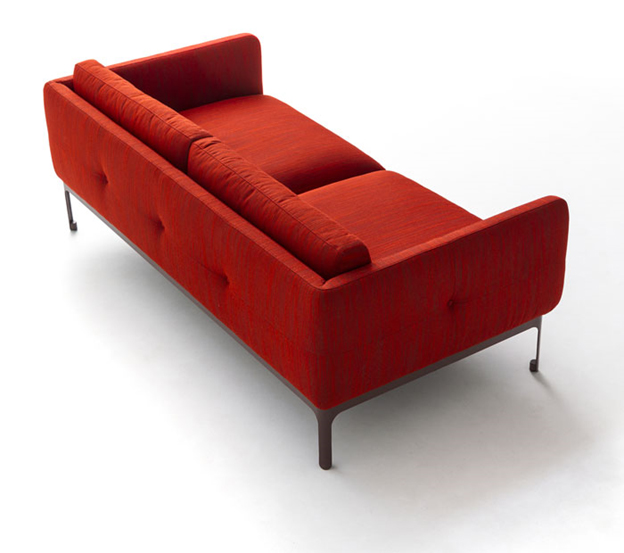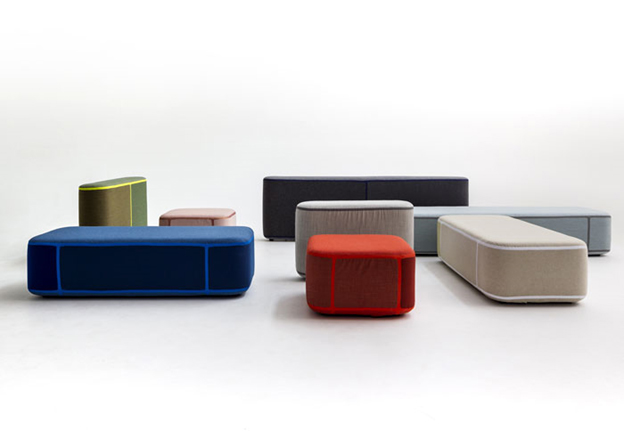Salone del Mobile 2018 is a platform for Moroso’s multifaceted personality, by way of a new collection where shapes, textures, materials, finishes, and colors organize and harmonize the mix of inspirations. Key players of the 2018 collection underline those who are the distinctive features of the company such as the traditional vocation for upholstered items, the new sofa Chamfer and an original version of Gentry, both by Patricia Urquiola, as well as Casa Modernista by Doshi Levien.
This Modernista collection – despite its roots and references lying within Modernism – distinguishes itself with its ambitious attempt to integrate the figurative component, representative of Nipa Doshi and Jonathan Levien’s work, to the linear rationality of the rectangle geometric shape.
The result, from a formal innovation point of view, is an achievement. The two designers contrast the classical composition, from the meticulous attention to the surface and material performance to the highlighting of a few meaningful traits: the central button denies and simultaneously reworks the capitonné padding bourgeois charm, while the base, revised through colour choice and the use of steel, tempers the aesthetics of industrial manufacturing.

With Casa Modernista – a subtle homage to Gregori Warchavchik, Russian-Ukrainian architect responsible for promoting modern architecture in the 1920’s Brazil – the formal precision and objective sobriety of the prior models is tempered, opening itself to relaxation and spontaneity. The cushions lose stiffness; the seating becomes deeper and welcoming, the lines softened. The sofa, through this change, becomes a space where opposite interpretations of time transit: productive and disconnected, social and personal, temporary and continuous.
Benjamin Hubert’s Tape collection uses polyurethane tape to bond smaller pieces of textile together, which would otherwise be discarded in the upholstery process and treated as waste. The technique was inspired by the sporting industry, where the tape is used in the construction of snowboarding, ski, and wet-weather gear.
The Tape sofa – the first modular sofa designed by LAYER – comprises a series of modernist building blocks that can be combined in various contrasting and complementary combinations to suit a diverse range of interior spaces and styles. Each modular block – seat, backrest, and arms – is subdivided into smaller textile panels which are bonded together using polyurethane tape. Pockets – which are connected to the arm modules using tape – can be used to gather and store papers, magazines, or remote controls.
An intuition born from carpentry terminology becomes the distinctive feature of a modular system, which is new regarding formal construction and innovative regarding compositional flexibility. Even though the literal interpretation of the term Chamfer refers to a smooth angle created with a 45° cut through a right angle, within this sofa, it expresses a twofold widening of aesthetical and functional perspective. On the outside, the Chamfer softens the shape and acts as a guide, its size conferring both a spatial and architectural value.

On the inside, the angle encloses and supports, favoring a versatile seating style that adapts perfectly to a residential environment as well as to public areas. Through five modules, different in length and depth, and a single junction, it is possible to imagine a multitude of combinations, from simple specular arrangements to well-structured geometrical sequences.
Edward van Vliet presented at the Salone del Mobile 2018 his second landscape design for Moroso named Josh. Josh is designed with the intention to be lived and as a place where to spend the day. It is the main player in the living room where everything starts. It fits perfectly in a city loft as much as in summer houses thanks to its natural touch coming from the cotton enriched with a stitched pattern reminiscent of the traditional Japanese futon and the printed linen ikebana graphics. The result is a beautiful match between rough natural fabric and latest printing technology.
YUMI is a family of products with a very simple principle and sophisticated language; its sinuous outlines and rapping shape create an inviting seating; a hollow backrest formed by a bent bow keeps it dean and light. Separated seat and backrest allows playing with endless combinations of fabric, leathers, and finishes.
YUMI’s style ranges from a woven playful version to a more a sophisticated upholstered version that makes the family suitable for residential and commercial spaces, indoor and outdoor. Its extensive family includes dining chairs, armchairs, lounge chairs, side tables, sofas and dining tables that will let interior designers and architects cover completely areas of a project with the same product on multiple and unique versions.
Seku chair for Mafrique Collection by Sebastian Herkner: Seku means in Wolof language, spoken in West Africa, parrot. The Seku chair is a cocktail armchair in bright color combinations. The seating shell is floating on a sled structure and is woven like a feather dress, while an additional cushion supports the comfort for outdoor.
DayTrip, for the outdoor collection Moroso M’Afrique, is a composition of multiple surfaces designed to be utilized as low tables and benches. The concept for the piece is rooted in Thorpe’s ethos of relational design. The user is offered an opportunity to arrange and design the setting of the surfaces themselves, allowing for their creative ownership and unique relationship with the product. The surfaces are produced in Dakar, Senegal, while the cushions are produced in Udine, Italy.
DayTrip celebrates the multi-cultural spirit of Moroso and traditional hand craftsmanship of Senegal. The product is but one within the larger collection of Moroso M’Afrique which represents the beauty of collaboration, diversity, and originality. The collection as a whole reflects the unification of cultures and poses a greater dialog around the meaning and values surrounding design as well as the roll of the designer in a global context.
Brutalism and Minimalism inspire the Pipe collection, with unique personality evoking cartoon heroes. A straight structure of wooden or metal tubes is upholstered with soft seating and backrest elements.
The Mathilda collection by Patricia Urquiola finds new versions, proposing a dining table, an armchair and two types of stools in different heights. The products all feature a colored band which connects the structural elements to each other, creating, by overlapping, a color game on materials, textures, and colors. The armchair and stool derive their form and flow from the comfortable chair while altering its dimensions, proportions, heights, thicknesses, and depths. The top of the all-wood table is held up by two trestles.
The Lilo family welcomes its new members that preserve the references to the Scandinavian style, the modernist idea of the 50’s adapting to the new pieces: a chaise longue and two armchairs.
Studio Olafur Eliasson: Both the table and the shelving system, made of multiplex boards and painted steel, are based on the geometry of the Greenlight module. The shelves are built around the negative rhombic space outlined by the modules, and the table refers to the modules form by incorporating fragments of their geometry. Like the lamps, the table was developed as modules: they can be combined into a hexagonal surface, lined up to create a zigzag row, or put together to create a star shape.



















Your Message